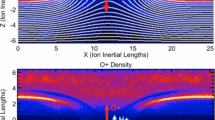Abstract
Narrow-band transmissivities in the spectral range of 150 to 9300 cm−1 and at a uniform resolution of 25 cm−1 were calculated using the statistical narrow-band (SNB) model with the band parameters of Soufiani and Taine, the more recent parameters of André and Vaillon, and the line-by-line (LBL) method along with the HITEMP-2010 spectroscopic database. Calculations of narrow-band transmissivity were conducted for gas columns of different lengths and containing different isothermal and non-isothermal CO2-H2O-N2 mixtures at 1 atm. Narrow-band transmissivities calculated by the SNB model are in large relative error at many bands. The more recent SNB model parameters of André and Vaillon are more accurate than the earlier parameters of Soufiani and Taine. The Planck mean absorption coefficients of CO2, H2O, CO, and CH4 in the temperature range of 300 to 2500 K were calculated using the LBL method and different versions of the high resolution transmission (HITRAN) and high-temperature spectroscopic absorption parameters (HITEMP) spectroscopic databases. The SNB model was also used to calculate the Planck mean absorption coefficients of these four radiating gases. The LBL results of the Planck mean absorption coefficient were compared with the classical results of Tien and those from the SNB model.
Similar content being viewed by others
References
Modest M F. Radiative Heat Transfer. 2nd ed. San Diego. New York: Academic Press, 2003
Denison M K, Webb B W. A spectral line-based weighted-sum-of-gray-gases model for arbitrary RTE solvers.Journal of Heat Transfer, 1993, 115(4): 1004–1012
Liu F S, Smallwood G J, Gülder Ö L. Application of the statistical narrow-band correlated-k method to low-resolution spectral intensity and radiative heat transfer calculations—effects of the quadrature scheme. International Journal of Heat and Mass Transfer, 2000, 43(17): 3119–3135
Modest M F, Zhang H M. The full-spectrum correlated-k distribution for thermal radiation from molecular gas-particulate mixtures. Journal of Heat Transfer, 2002, 124(1): 30–38
André F, Vaillon R. The spectral-line moment-based (SLMB) modeling of the wide band and global blackbody-weighted transmission function and cumulative distribution function of the absorption coefficient in uniform gaseous media. Journal of Quantitative Spectroscopy & Radiative Transfer, 2008, 109(14): 2401–2416
Zhang J Q, Cheng J S. Determination of the temperature profile of axisymmetric combustion-gas flow from infrared spectral measurements. Combustion and Flame, 1986, 65(2): 163–176
Malkmus W. Random Lorentz band model with exponential-tailed S — 1 line-intensity distribution function. Journal of the Optical Society of America, 1967, 57(3): 323–329
Modest M F. Narrow-band and full-spectrum k-distributions for radiative heat transfer correlated-k vs. scaling approximation. Journal of Quantitative Spectroscopy & Radiative Transfer, 2003, 76(1): 69–83
Chu H Q, Liu F S, Zhou H C. Calculations of gas thermal radiation transfer in one-dimensional planar enclosure using LBL and SNB models. International Journal of Heat and Mass Transfer, 2011, 54(21–22): 4736–4745
Rothman L S. The evolution and impact of the HITRAN molecular spectroscopic database. Journal of Quantitative Spectroscopy & Radiative Transfer, 2010, 111(11): 1565–1567
Rothman L S, Gordon I E, Barber R J, Dothe H, Gamache R R, Goldman A, Perevalov V I, Tashkun S A, Tennyson J. HITEMP, the high-temperature molecular spectroscopic database. Journal of Quantitative Spectroscopy & Radiative Transfer, 2010, 111(15): 2139–2150
Tashkun S A, Perevalov V I, Teffo J L, Bykov A D, Lavrentieva N N. CDSD-1000, the high-temperature carbon dioxide spectroscopic databank. Journal of Quantitative Spectroscopy & Radiative Transfer, 2003, 82(1–4): 165–196
Soufiani A, Taine J. High temperature gas radiative property parameters of statistical narrow band model for H2O, CO2 and CO, and correlated k model for H2O and CO2. International Journal of Heat and Mass Transfer, 1997, 40(4): 987–991
André F, Vaillon R. A nonuniform narrow band correlated-k approximation using the k-moment method. Journal of Quantitative Spectroscopy & Radiative Transfer, 2010, 111(12-13): 1900–1911
Zhang HM, Modest MF. Evaluation of the Planck-mean absorption coefficients from HITRAN and HITEMP databases. Journal of Quantitative Spectroscopy & Radiative Transfer, 2002, 73(6): 649–653
Taine J. A line by line calculation of low-resolution radiative properties of CO2-CO-transparent nonisothermal gas mixtures up to 3000 K. Journal of Quantitative Spectroscopy & Radiative Transfer, 1983, 30(4): 371–379
Taine J, Soufiani A. Gas IR radiative properties: from spectroscopic data to approximate models. Advances in Heat Transfer, 1999, 33: 295–414
Godson W L. The evaluation of infra-red radiative fluxes due to atmospheric water vapor. Quarterly Journal of the Royal Meteorological Society, 1953, 79(341): 367–379
Kim T K, Menart J A, Lee H S. Non-grey radiative gas analysis using the S-N discrete ordinates method. ASME Journal of Heat Transfer, 1991, 113(4): 946–952
Ju Y G, Guo H S, Liu F S, Maruta K. Effects of the Lewis number and radiative heat loss on the bifurcation and extinction of CH4/O2-N2-He flames. Journal of Fluid Mechanics, 1999, 379: 165–190
Hartmann J M, Levi Di Leon R, Taine J. Line-by-line and narrowband statistical model calculations for H2O. Journal of Quantitative Spectroscopy & Radiative Transfer, 1984, 32(2): 119–127
Perrin M Y, Soufiani A. Approximate radiative properties of methane at high temperature. Journal of Quantitative Spectroscopy & Radiative Transfer, 2007, 103(1): 3–13
Tien C L. Thermal radiation properties of gases. Advances in Heat Transfer, 1968, 5: 253–324
Author information
Authors and Affiliations
Corresponding author
Rights and permissions
About this article
Cite this article
Chu, H., Gu, M., Zhou, H. et al. Calculations of narrow-band transimissities and the Planck mean absorption coefficients of real gases using line-by-line and statistical narrow-band models. Front. Energy 8, 41–48 (2014). https://doi.org/10.1007/s11708-013-0292-4
Received:
Accepted:
Published:
Issue Date:
DOI: https://doi.org/10.1007/s11708-013-0292-4




